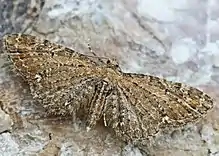Currant pug
The currant pug (Eupithecia assimilata) is a moth of the family Geometridae. The species was first described by Henry Doubleday in 1856. It is found across the Nearctic and Palearctic regions and the Near East.
| Currant pug | |
|---|---|
 | |
 | |
| Scientific classification | |
| Kingdom: | Animalia |
| Phylum: | Arthropoda |
| Class: | Insecta |
| Order: | Lepidoptera |
| Family: | Geometridae |
| Genus: | Eupithecia |
| Species: | E. assimilata |
| Binomial name | |
| Eupithecia assimilata | |
| Synonyms | |
| |
This species is rather similar to the wormwood pug, with warm brown forewings and a triangle of black spots close to the costa, but can be recognized by its broader wings and a more prominent white spot close to the tornus. The wingspan is 17–22 mm. Two broods are produced each year with adults on the wing in May and June and again in August.
The larva, as the name suggests, feeds on currant, but will also feed on hop. The species overwinters as a pupa.
References
- Yu, Dicky Sick Ki. "Eupithecia assimilata Doubleday 1856". Home of Ichneumonoidea. Taxapad. Archived from the original on 25 March 2016.
- Chinery, Michael. Collins Guide to the Insects of Britain and Western Europe (1986, reprinted 1991)
- Skinner, Bernard. Colour Identification Guide to Moths of the British Isles (1984)
| Wikimedia Commons has media related to Eupithecia assimilata. |
External links
This article is issued from Wikipedia. The text is licensed under Creative Commons - Attribution - Sharealike. Additional terms may apply for the media files.